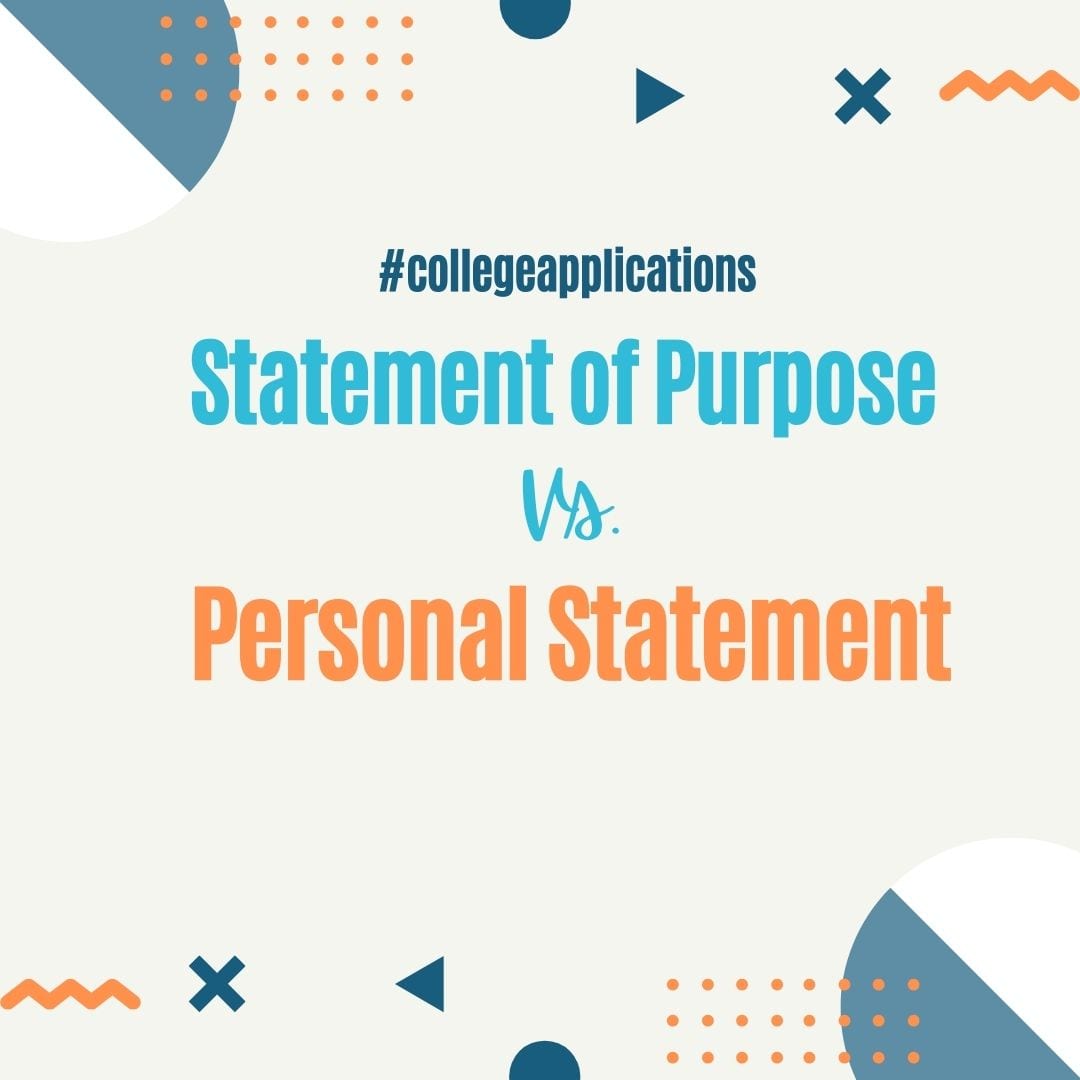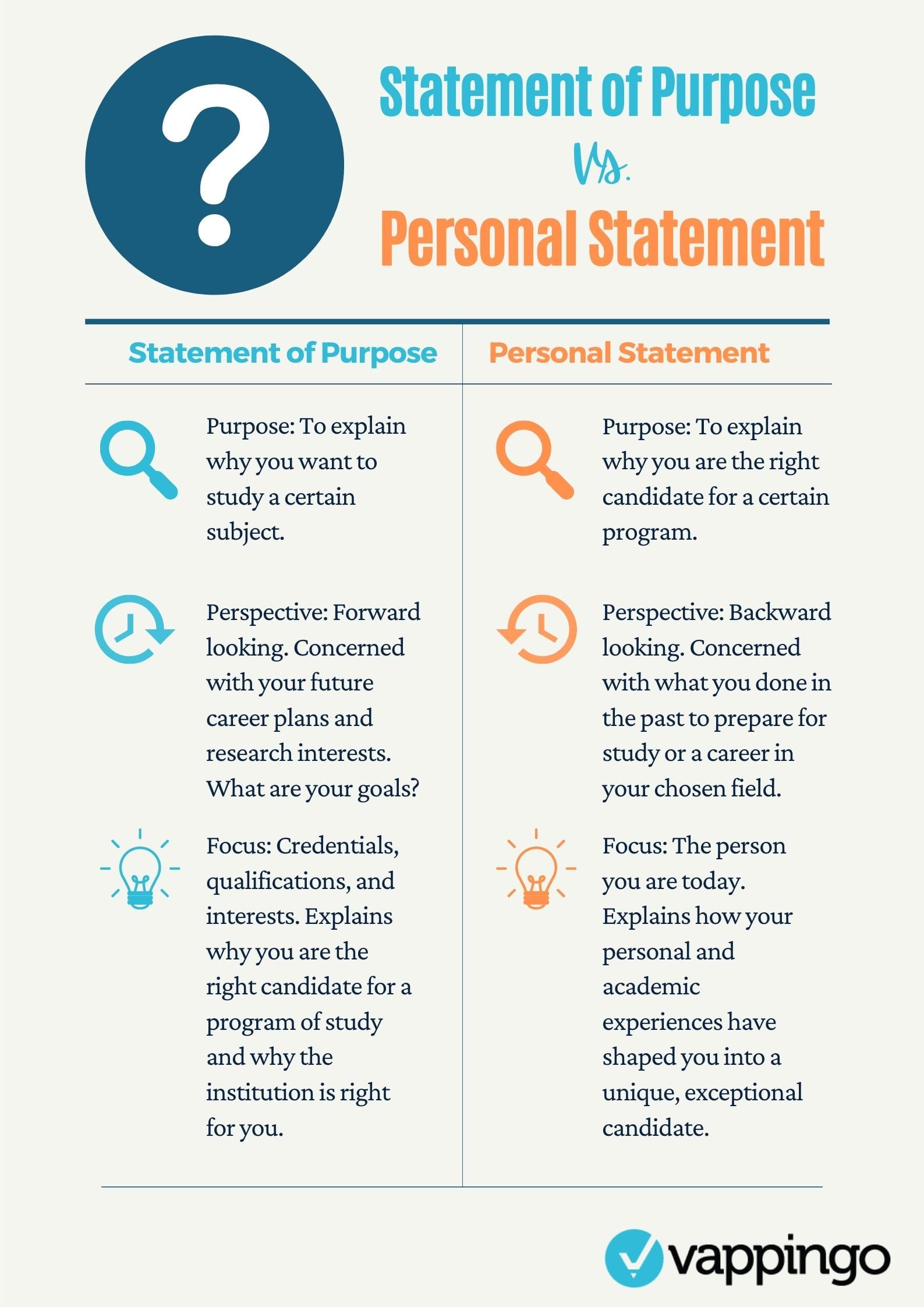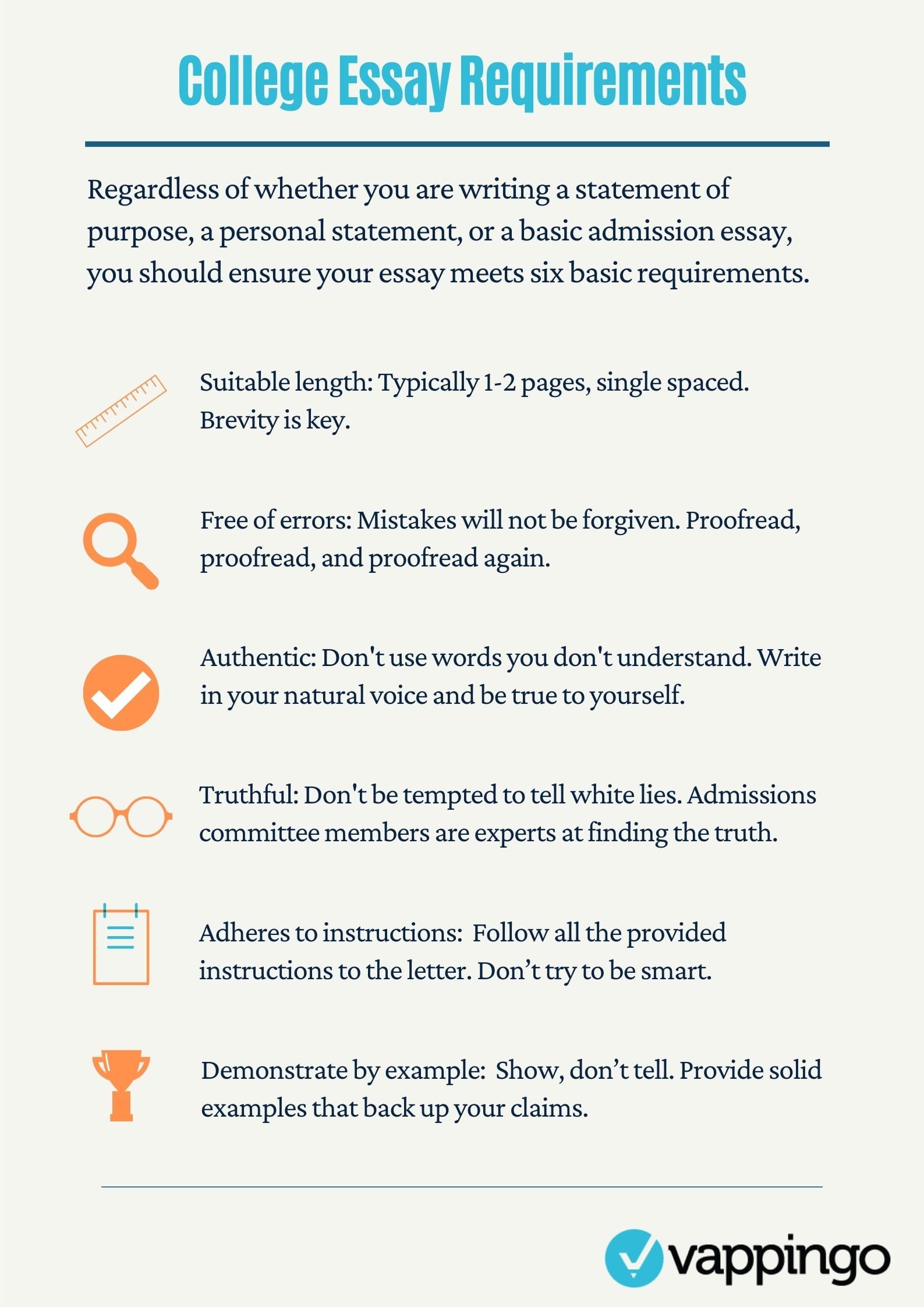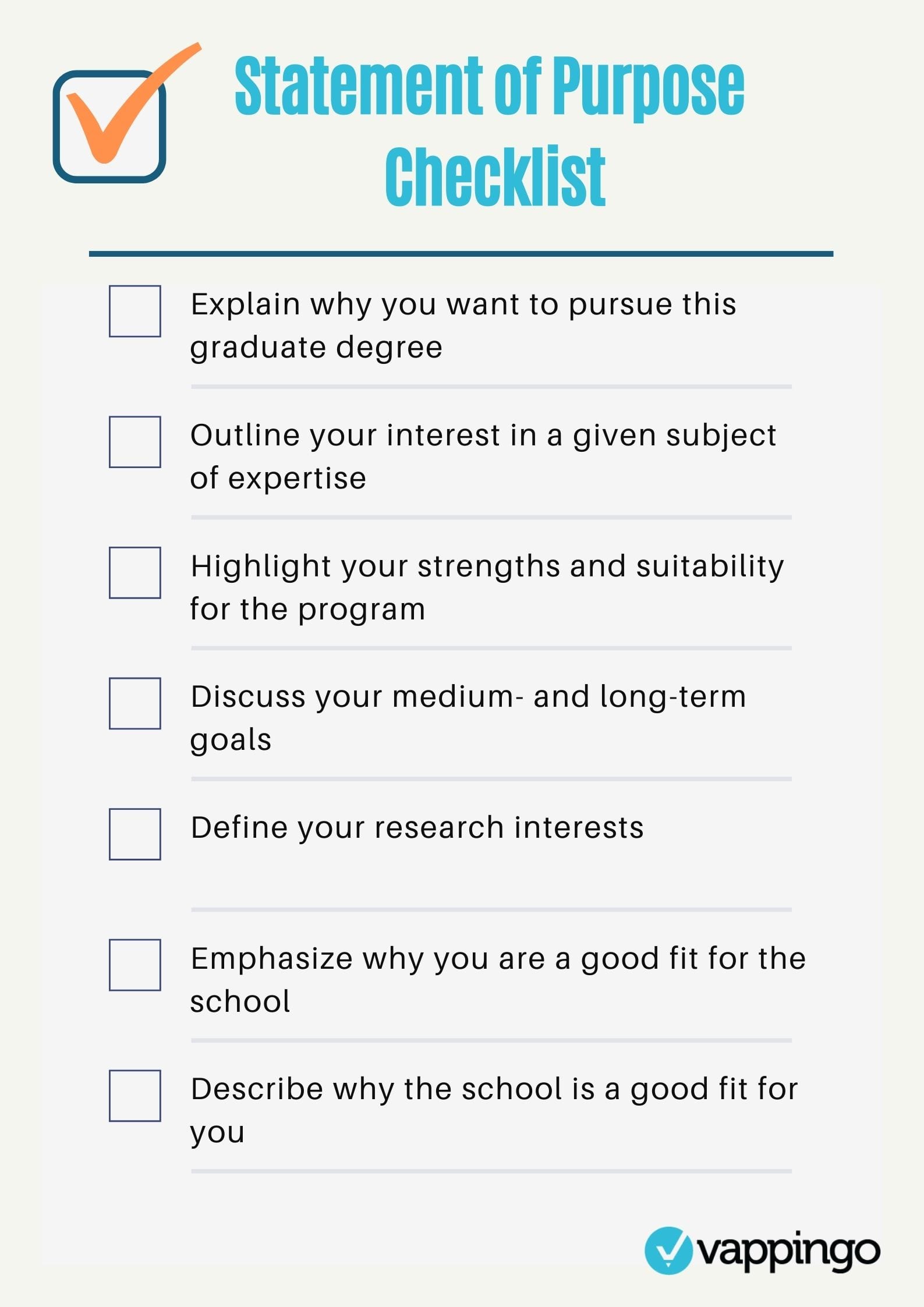Confused about the differences between a statement of purpose and a personal statement? This article contains all the information you need to make sure you nail your admissions essay.

Every applicant to grad school will likely be asked to write some kind of statement to support his or her application.
In some cases, you’ll be asked to write a personal statement; in others, you will be requested to write a statement of purpose. In the worst-case scenario, you’ll be asked to write both (and maybe an additional admissions essay to boot!).
Off the bat, you need to know this: There is a difference between a statement of purpose and a personal statement.
In fact, there are several differences.
So now we’ve established that a statement of purpose is not the same as a personal statement, let’s take a look at some of the ways in which the two essays differ.
Quick note: Are you currently writing your statement of purpose? Need your statement of purpose to be as strong as it can be? Ivy League editors are here to help. Our college essay experts can help you shine. Check out our SOP editing services now.
Differences Between a Statement of Purpose and a Personal Statement

SOPs and personal statements differ in three broad ways:
1) The purpose
While the fundamental purpose of your statement of purpose is to explain why you want to study a given subject, the purpose of the personal statement is to explain why you are the right candidate for the program.
2) The perspective
The statement of purpose is forward-looking. It is concerned with your overall purpose (clue in the title, guys). In this case, admissions committees are looking for specific detail on your future career plans and research goals. The personal statement is more of a reflection; as such, it is predominantly backwards-looking. It is concerned with what you have done in the past to prepare for study or a career in your chosen field.
3) The focus
The focus of your statement of purpose should be firmly placed on your credentials, qualifications, and interests. The SOP should explain why you are the right candidate for a program of study and why the institution is right for you. The focus of your personal statement should be on the person you are today. Explain how your personal and academic experiences have shaped you into a unique, exceptional candidate.
While both essays share the same ultimate objective—to secure your admission to the university by convincing the admissions committee that you have the potential to be a success on the program to which you are applying for admission—the expectations differ. It is imperative that you know what these expectations are to ensure you give the admissions committee members the information they are looking for.
So, now we’ve provided a high-level overview of the differences between a statement of purpose and a personal statement, it is worth looking at some of the features these two essays have in common.
Similarities Between a Statement of Purpose and a Personal Statement
Regardless of whether you are writing a statement of purpose or a personal statement, you will need to ensure you meet six basic requirements.

1) Suitable length
Unless the specific school states otherwise, both types of admission essays should be between 1-2 pages (single-space pages in 12-point font). Some schools will provide a word limit. In those cases, you should strictly adhere to the requirements. In other cases, you may be given free rein. Brevity is key. While you may be tempted to write a four-page monologue that gives extensive details of your suitability for the program, this approach is typically ineffective and will not maintain the reader’s attention.
Bear in mind that admissions committees receive thousands of applications for every place on a given program. They appreciate concise, well-written essays that focus on your uniqueness. Think of it as an elevator pitch. You only have a couple of minutes to persuade the reader that you will bring value to the program. Make every word count.
For more details on how to format a statement of purpose, check out our guide to the statement of purpose format. You may also find our statement of purpose samples useful.
2) Free of errors
Even if you do not go the whole hog and engage the services of an expert SOP editing service, you should enlist the services of a third party to proofread your final essay. Mistakes are unforgivable and will result in your well-crafted personal statement or statement of purpose being tossed on the reject pile.
3) Authentic
Don’t try to use words you don’t understand or flowery language that would rival a Shakespearean sonnet. Just be you. Write in your natural voice and be true to yourself. This approach will ensure that your personal statement of SOP is much more relatable to the reviewers.
A professional statement of purpose editor can help you maintain an authentic voice. Take a look at our guide to finding the best SOP editor for more help.
4) Truthful
Do not tell lies in your admissions essays. Admissions committee members are experts at weeding out the truth. Any white lies could cost you the place at the university of your dreams.
5) Adheres to instructions
Follow all the provided instructions to the letter. Don’t try to be smart or creative by circumventing the requirements. The reviewers will initially screen your essay against these requirements; if they have not been met, your admissions journey will come to an end. Take a look at our guide to statement of purpose mistakes for more assistance.
6) Demonstrates by example
Show, don’t tell. Instead of claiming that you are a strong communicator, for instance, provide a solid example that demonstrates your strong communication skills in action.
Objectives of a Personal Statement
Your personal statement should achieve four broad objectives:
1) Tell a story
Regardless of whether you actually format your personal statement in story form, it should lead the reviewers through a journey by which they learn about you as a unique candidate.
2) Outline your motivations
Your task is to convince the admissions tutors that you understand the course and are a good fit for what they have on offer. Thoroughly research the program and the university and use your personal statement to demonstrate that you have taken the effort to find out about the school and the course of your choice.
What do you love about your chosen subject so much that has motivated you to choose it above anything else? Demonstrate your passion, intellectual curiosity, and enthusiasm.
3) Be succinct and compelling
The story you tell needs to be compelling and remarkable. By adding concise detail, you can catch the reviewer’s heart and leave a lasting impression.
Regardless of what story you choose to tell, make sure it is unique. Write as though you are talking directly to the reader.
4) To explain any weaknesses or challenges you have overcome
If there is an elephant in the room; i.e., something that you are concerned will have a negative impact on your application, the personal statement is the place to mention it. You may be tempted to ignore your weaknesses completely. However, if there is a chance the admissions committee will ask questions about something—for example, your grades, a gap in your work experience, or a health issue—you should use your PS to explain these weaknesses.
For instance, let’s say your GPA dropped significantly during your freshman year because you experienced an issue with your mental health. You can use your personal statement to discuss the adversity you encountered, how you overcame it, and most importantly, what you learned from the experience.
Regardless of the weakness or challenge you describe, make sure you present the story in a positive light. This will help the admissions committee to recognize that you are tenacious and have the potential to strive in the face of challenges.
Personal Statement Checklist

Free PDF download: Personal Statement Checklist
An impressive personal statement should:
- Tell your unique story
- Outline your motivations
- Be succinct and compelling
- Address any weaknesses the committee may question
Objectives of a Statement of Purpose
When writing a statement of purpose, you should ensure that it meets six broad objectives:
1) Explain why you want to pursue this graduate degree
As we previously described, the most important part of your statement of purpose is the purpose. You need to clearly and succinctly explain why you want to pursue a given program of study.
Do you want to transition from the corporate world to academia but need to study your subject of expertise at a higher level to make this move? Or perhaps you want to complete an MBA to enable you to progress within the company you work for?
Regardless of what your goals are, you need to very clearly explain what is motivating your interest in pursuing a graduate degree.
2) Explain your interest in a given subject of interest
It’s not enough to simply state why you want to study a given discipline. You need to convince the admissions committee that you are dedicated to that particular field of study.
Briefly provide an outline of the experiences that have stimulated and maintained your interest in the subject. For example, work experience, voluntary work, internships, etc. If a mentor has inspired you or provided expert guidance that has fostered your motivation, talk about the impact the individual has had on your goals. Clearly communicate your preparedness for study.
3) Outline your strengths and suitability for the program
In this section of your SOP, you need to clearly outline any experience you have that will enable you to be successful on the program. Be it academic, professional, or internship experience, describe the skills and knowledge you have gained that have added to your understanding of the subject of interest and solidified your intention to study it at a higher level.
Ensure you explicitly spell out how your strengths will enable you to be successful on the program. This will help you to demonstrate that you have a clear understanding of what the program involves and will be a positive addition to the class.
4) Outline your medium and long-term goals
Clearly outline your medium- and long-term goals. What do you hope to achieve after completing the program of study?
What is your ultimate objective? For example, in the medium term, you may wish to progress to become a team leader in the organization at which you work before ultimately becoming a division head. Or perhaps you want to dedicate your career to research to facilitate developments in your field of interest. Be specific.
5) Define your research interests
This section of your statement of purpose is particularly important. Describe what specifically you would like to research if you are admitted to the program. Most importantly, highlight how these research interests are aligned with the ongoing studies of the current faculty members.
Name the professors at the school who you are interested in working with and explain how their studies fit in with your objectives. You will need to tailor this section to each school. While this may mean a bit of extra work, it reassures the admissions committee members that you understand the nature of the program and will bring value to the school.
6) Highlight why you are a good fit for the school
As stated earlier, thousands of applicants apply for every place on a given course of study. So why should the school choose you? Your goal is to convince the reviewers that you are the right candidate for them.
Specifically, highlight how your values and motivations are aligned with those of the institution to which you are applying.
What unique strengths will you bring to the faculty? How will you add value? Discuss the knowledge, skills, and experiences you anticipate accessing from the program and highlight how these will enable you to achieve your medium- and long-term goals.
7) Detail why the school is a good fit for you
Demonstrate that you have thoroughly researched the program on offer and the unique benefits of the school to which you are applying. Again, this section will be different for every application. Describing the attributes of the program and school that have attracted you will help you to craft an informed statement of purpose that the faculty members who are reviewing your application can relate to.
Read more: How to write a statement of purpose
Statement of Purpose Checklist

Free PDF download: Statement of Purpose Checklist
An impressive statement of purpose should demonstrate:
- Why you want to pursue this graduate degree
- Your interest in a given subject of expertise
- Your strengths and suitability for the program
- Your medium and long-term goals
- Your research interests
- Why you are a good fit for the school
- Why the school is a good fit for you
Remember: Once you have written the first draft of your personal statement or statement of purpose, you will need to ensure it is thoroughly proofread. Our statement of purpose editors can help you to refine and perfect your SOP. In addition to correcting any spelling, punctuation, and grammatical errors, they will help you identify any gaps in content, provide advice on how you can improve your statement, and identify any irrelevant content.
Statement of Purpose vs Personal Statement: Which Do You Need to Write?
Hopefully, you now have a clear understanding of the main differences between a personal statement and a statement of purpose.
But which one do you actually need to write?
The answer to this question will be down to which school and program you are applying for admission to. Some schools require either a personal statement or a statement of purpose, while others require both.
For example, MIT requires a statement of purpose, while Indiana University requires a personal statement.
In some cases, the school may require an essay that is a combination of both a personal statement and a statement of purpose. For instance, the London School of Economics requires a specific format for some programs of study.
In the worst-case scenario, you may encounter a school that uses the terms statement of purpose and personal statement interchangeably.
In this case, you should take into consideration the nature of the program for which you are applying. Generally speaking, research-based programs will expect an academic, formal statement of purpose (especially at PhD level), while undergraduate or scholarship applications typically require a personal statement.
If there’s any doubt, clarify the requirements. You should be able to find the details on the application itself or the school’s website. If this information is missing, contact the school directly to double-check the expectations.
Conclusion: The Difference Between a Statement of Purpose and a Personal Statement
There are major differences between a personal statement and a statement of purpose, and it’s imperative that you know what these are.
Although both essays share the fundamental goal of securing you a place on the program of study of your choice, the information and requirements associated with the two statements are vastly different.
At a high level, the SOP is the more formal essay. It highlights your academic and professional background and what you have achieved. However, its biggest focus is on your purpose. As such, you should invest significant effort in defining your goals and how the program and school will help you achieve those goals.
The statement of purpose is typically less formal. It is heavily focused on you as a unique candidate. It should include some form of story that sets you apart as an exceptional individual who will add value to the program.
Regardless of whether you are writing a statement of purpose or a personal statement, make sure you do the following:
- Read the instructions carefully
- Use specific details and examples
- Be authentic
- Edit and proofread your final statement of purpose or personal statement!


6 thoughts on “The REAL Differences Between a Statement of Purpose and a Personal Statement”
Comments are closed.